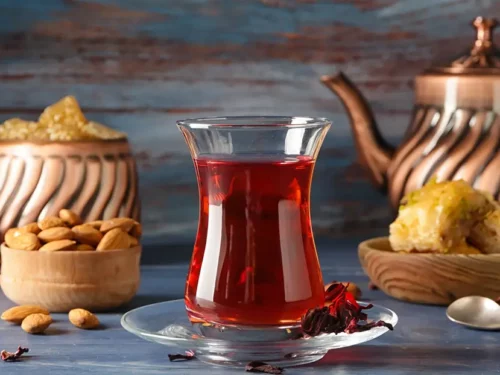
We have been asked a lot of questions in regards to tea, so we thought we would answer some of the most frequently asked questions presented by none other than our inquisitive tea community. We hope our answers help to resolve any of your burning questions. If there is a particular question that we did not address, or you would want to know more about, do not hesitate to email us at: admin@harumadetea.com and we will be delighted to respond to your query.
Turkish Tea FAQ’s
What is so special about Turkish tea– When we say Turkish tea, we are talking about Turkey’s national drink- the traditional Turkish black tea (siyah çay). It is cultivated in the unique climate of the Black Sea Region, delivering its distinct flavour, which is then brewed in a double teapot (çaydanlık) on stovetop. It is through this unique brewing method that makes Turkish tea so special. Turkish tea is also known for its large variety of herbal teas, brewed the regular way.
Can you add milk and sugar to Turkish tea– Turkish tea is traditionally served without milk, as adding milk is not a common practice in Turkish tea culture. However, if you are brewing at home, there is no stopping you from adding milk if you desire. As for sugar, small sugar cubes are normally served alongside your tea, and is widely accepted to sweeten according to your taste.
When should I drink Turkish tea– The simple answer would be any hour of the day. Turkish people start off their day with a glass of Turkish tea and most commonly continue drinking during their daily activities- at work, socially, after meals. Offering tea is a social gesture of welcome in Turkey, and if offered, it is considered rude to refuse. In other words, there is never a time to not drink Turkish tea. However, due to high levels of caffeine, you may want to try and avoid drinking it before bed.
Is Turkish tea good for blood pressure– Yes, Turkish tea contains high levels of antioxidants that help to lower cholesterol and reduce blood pressure. A variety of Turkish herbal teas also attain to aid in cardiovascular health, including and not limited to apple, pomegranate, and rosehip tea.
What is Turkish tea made of– Traditional Turkish black tea is made from the heavily oxidised leaves of the Camellia Sinensis plant that is grown in the Black Sea Region in Turkey. Turkish tea is primarily sourced in the Black Sea Region due to its optimum growing conditions. Whereas Turkish herbal teas are made from an infusion of fruits, herbs, spices, and flowers.
What is the difference between Turkish tea and regular tea– The main difference between Turkish tea and regular tea is in the method they are brewed and served. Both are made from the leaves of the Camellia Sinensis plant, however, Turkish tea is brewed in a double teapot and served in small tulip shaped glasses (ince belli) which allows the tea to retain its temperature, whilst marvelling at its lovely crimson colour. It is commonly served with sugar cubes and a glass of water (because it is strong). Whereas regular tea is brewed in a single teapot or kettle, and depending on the type of tea, can be served on its own or with milk and sugar.
How to make proper Turkish tea– Using a double teapot is the traditional method, but it can also be made without.
Double teapot method: Place tea leaves and some water in the top teapot (about 1 teaspoon of tea per glass), and hot water in the bottom. Place on the stove and bring water to boil, once boiled, reduce heat to low, and let it steep for 15 minutes. To serve: Pour about 1/3 of the glass with the concentrated brewed tea, and top up the rest with the boiling water. This can be adjusted to suit your taste, but you should be left with a tea that is red in colour.
Two pot method: In a small pot, boil your water and add one teaspoon of tea per glass. Turn the heat down to low and brew for 15 minutes. In another pot or kettle, boil more water. To serve: Same method as above.
Why is Turkish tea red– The leaves from the Camellia Sinensis plant are originally green, and then picked to undergo oxidation (exposure to oxygen turns the leaves darker). Turkish tea leaves are oxidised until they become a black tea. Like most black teas, when brewed, they will contain a reddish colour. The prime climate location on the Black Sea, helps to produce Turkey’s high-quality black tea leaves, which produce a lovely crimson colour when steeped.
Why is Turkish tea made in a double teapot– The double teapot method is used to ensure the tea leaves are not directly placed under heat, heating them more slowly, reducing the risk of the leaves burning. This makes for a smoother, richer flavour when brewed. The strength of the tea in the top pot can also be adjusted whilst the pot is brewing, and the heat from the bottom pot simultaneously keeps the tea warm whilst it slowly brews.
Why does my Turkish tea taste bitter– Turkish black tea is known for having a strong bitter taste, even when it is brewed smoothly. For some people, the strength is too much, hence adding sugar cubes to the tea could make it more enjoyable. If making it yourself, the problem could be over steeping, so make sure you steep for around 15 minutes, and no more than 20 minutes on a low heat.
Regular Tea FAQ’s
What is the most popular tea in the world– Black tea is the highest consumed tea across the globe, with Assam black tea, grown in the Assam region of India, being the most popular choice. It is also the strongest in terms of taste and full body.
Where do you store your tea– The best place to store your tea is in a dry, dark place, in an airtight container away from the sun or light. Avoid plastic containers as they tend to absorb odours- containers made of glass, ceramic, metal, and tin are all good storing options. When choosing a place in your kitchen, avoid humid areas and strong-smelling odours such as spices or coffee, as tea absorbs moisture and odour very easily. This can result in your tea going stale and losing its fresh flavour. The five things to remember to avoid when storing tea are: Moisture, air, light, heat, and odour.
How long will tea store for– If you do the above and keep your tea away from any exposure that may degrade its quality, your tea should be able to last 2-3 years. Even though consuming expired tea is unlikely to be harmful to your health, the quality of the tea may be noticeable and unenjoyable.
How do I know if my tea has expired– Signs to look for are loss of aroma and flavour- if your tea is no longer smelling fresh, has developed a musty smell, or the flavour tastes almost stale, then it may be a sign that your tea has exceeded its use by date. A change in colour when brewing is another indication that it might be time for a new batch of tea. This may also be noticeable in the form of dusty tea leaves. Whilst you are inspecting your tea, keep an eye out for mould or insects that may have inhabited its space, as there is no clearer sign that your tea is no longer safe to drink.
Can I freeze my tea bags– Nothing beats storing your tea bags in a dry, dark, and sealed storage space- however, if you want to freeze your tea bags or loose-leaf tea, you can if they are sealed in an airtight container. Black, green, and oolong teas hold the best in the freezer as their structure remains intact after thawing, though, they need to be brewed right away, as they begin to steep as soon as they start to thaw. Herbal teas made with dried fruits and herbs may not benefit from freezing as it can inhibit their flavour. Re-freezing is not an option for any tea, as the structure of the tea will begin to inflict damage.
Can I store my tea in the fridge– If you are storing your tea to consume, I would not recommend storing your tea in the fridge. Unlike the freezer, the fridge harbours food odours which are very susceptible to tea. Taking your tea out of the fridge to use also poses the problem of condensation- the moisture will ruin your tea. If your tea is completely sealed and airtight, then it can technically go in the fridge, but when removing, you will have to wait until the entire tea has come down to room temperature before opening to avoid condensation. It seems like a fair bit of effort to preserve your tea, when it simply will thrive in conditions much better than your fridge.
Is tea bad to drink on an empty stomach– Yes, drinking hot tea on an empty stomach can cause irritation in the stomach lining, leading to discomfort, bloating, and nausea. It can also lead to build up in acidity caused by certain compounds such as tannins and catechins found in tea. Headaches can also be a symptom if the tea contains high levels of caffeine, whilst the presence of polyphenols in tea can lower the body’s ability to absorb nutrients such as iron from food.
What is the best tea to drink for beginners– I would suggest something light to begin with, something like a green tea (sencha or Longjing). However, if they are someone who enjoys stronger flavours, then a black tea (with or without milk) or Earl Grey might be an option. If they are someone who enjoys floral, a light oolong could be a good pick too.
Can too much tea be bad for you– Consuming tea with too much caffeine can cause unwanted side effects such as headaches, anxiety, restlessness, and sleep deprivation. Pregnant women should also avoid caffeine as it can affect their unborn child. Too much tea can also lead to the same symptoms caused by drinking tea on an empty stomach, such as nausea, acid reflux, and reduced iron absorption. How much is too much? That all depends on the individual and the type of tea. I would say anywhere between 4-6 cups a day would be a maximum for most people.
How many types of tea are there– It is estimated that there are over 1,500 varieties of tea in the world, possibly extending all the way up to 3,000. However, with so many varieties, there are only 6 main types of tea derived from the Camellia Sinensis plant. These categories fall into: Green (minimally oxidised), white (slightly oxidised), yellow (partly oxidised), oolong (semi oxidised), black (fully oxidised), and Pu-erh (fully oxidised and fermented). Herbal tea is technically not classified as a true tea as it does not originate from the Camellia Sinensis plant. However, we all recognise its astounding health benefits as its very own tea.


